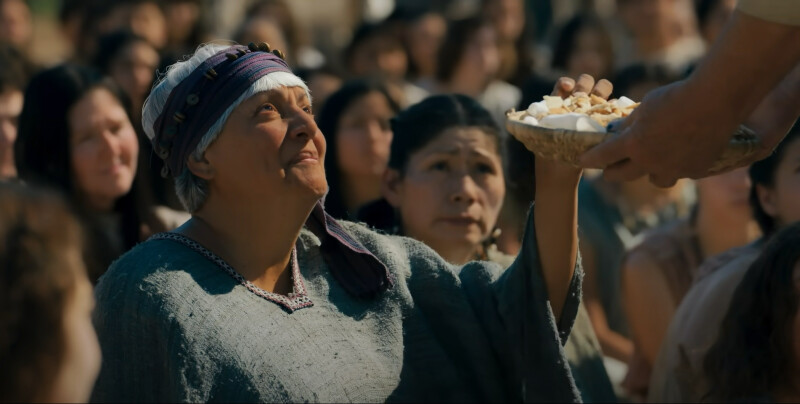As a busy mom of two kids, I find that I often don’t have time to write down stories or events from my kids’ lives as much as I would like to. Instead, I take pictures or videos to explain and record moments that I want to remember.
I often think of the scriptures as a type of journal, but unlike me, those who recorded Book of Mormon events did not have the luxury of things like photographs or videos to give additional detail and context, meaning that a lot of those smaller details are left to the reader’s interpretation and research. But when it comes to turning scripture stories into videos, such as with the Church’s recent Book of Mormon videos, it is precisely those small visual details from location to clothing to facial expressions that can really make a familiar scripture story come to life. That’s why I appreciated so many of the interpreted details of season four of the Book of Mormon videos: they really turned these chapters from stories to reality for me and made them relatable to my own life in a new and powerful way. Whether you’ve had a hard time connecting to the scriptures or simply want to see scripture stories from a new perspective, I highly recommend checking out the latest season of the Book of Mormon videos. Here are six added details I particularly loved from this season’s videos.
1. There are people from a variety of backgrounds.
Book of Mormon accounts primarily tell the story of a group of people or the experiences of one person, often a prophet or missionary. What we don’t really read about is the everyday individuals—people who were probably a lot like us, just living their lives and dealing with their own challenges. However, in the first episode of season 4, I was touched by the representation of these unnamed individuals. Many different kinds of families and people were shown navigating the destruction described in 3rd Nephi that came after the death of Christ, for instance, an elderly couple who barely survived an earthquake, a blind daughter fearfully trying to follow her parents through collapsing buildings, a mother cradling a newborn during the three days of darkness, and a pair of sisters who discovered a surviving group of young orphans. These were all scenarios that I had not considered, but they created a new spiritual connection to the Book of Mormon for me. Humans crave connection, so when we find a story about someone with similar struggles or experiences who has overcome them, we feel seen, understood, and hopeful about our own future, which was the case for me when watching this interpretation of 3rd Nephi.
I was delighted that the same unnamed people introduced in the first episode are seen throughout the season, journeying to Bountiful, seeing Jesus Christ appear, sitting around the temple listening to the Savior, partaking of the sacrament, and being baptized. It’s easy to forget the challenges we all endure on our individual journeys to Christ, but this visual reminder of these individuals’ renewed faith can bring hope and peace in our own personal journey to Christ.
2. We get to watch the journey to Bountiful.
Unlike most portrayals of the scenes in the Americas after Christ’s death, episode one did not skip from the three days of darkness straight to the Savior’s appearance, nor did it stay in the land Bountiful. Instead, it imagined the aftermath of the storms for those who did not live near the temple, showing the likely challenges the survivors encountered on their journey to gather in Bountiful. We also see people helping each other on that journey in spite of their own injuries and trauma. Seeing their struggles and their charity sets up the scene for Christ’s appearance in a beautiful way, clearly reminding us how destitute and humble the people were and how much they really needed Christ’s love and help. There is something powerful about considering the details and reality of this experience—watching the prophet Nephi directing humanitarian efforts as people arrive, future disciples working together to provide resources and having joyful reunions, hearing reports of the destruction and changes that took place, and tackling the massive challenge of rebuilding after so many disasters. Though the Book of Mormon peoples lived long ago, their traumas, family situations, spiritual needs, and emotions are familiar, reminding me of my own desperate need for the Savior’s loving help and guidance as well.
3. There is always a record keeper.
In episode two, after the disciples of Christ were called, one disciple became a scribe throughout the rest of the episodes. I love this image of one disciple being specificially responsible for recording all of Christ’s words—the words that we now read in the Book of Mormon. Today, we still keep records of the words of the prophets, records of baptisms, and many other things, so it makes sense that it would have been done when Christ organized His Church in the Americas. As a writer, it especially helped bring the words of Christ to life for me, thinking about who actually might have heard and recorded these spiritually significant events and what tools they might have used to preserve the words of their Savior. So much effort was made to make sure we can read those words today, and it served as a good reminder of the importance in keeping our own careful records of revelation and spiritual experiences.
4. There is a visual emphasis on individuals.
As a woman and a wife, I appreciated that the prophet Nephi’s wife is included in many of Nephi’s scenes. She is by his side helping with humanitarian efforts in the first episode, she is one of the avid listeners in the audience throughout the episodes, and Nephi brings her the sacrament during episode six. Though Nephi’s wife’s story is not shared in the pages of the Book of Mormon, it was not hard to picture her by her husband’s side, much in the same way our own prophet’s wife, Sister Wendy Watson Nelson, supports her husband today. Again, it just reminded me that the same church was restored in our time.
► You may also like: What’s it like to be married to President Nelson? Sister Wendy Nelson shares delightful stories and insights
Episode eight also includes a group of young men and young women. During the scenes of Christ teaching, He often calls an individual up to stand next to Him as He teaches. I liked this filming decision because, while we have no way of knowing if it actually happened, it really emphasizes the “one by one” way Christ always ministers. But what struck me even more was that during episode eight when Christ is teaching about the gathering of Israel, instead of beckoning people up one at a time, He beckons to one person, then another, and another, until a small group of people are standing next to Him. This visual “gathering” or what to me looked like teenagers and young adults was a striking reminder to me of the love Christ and Heavenly Father have for an age group that is often overlooked in scripture. We hear often of the important role youth have in gathering Israel, and this was a subtle but powerful visual reminder of that.
5. We hear an interpretation of Christ’s tone of voice.
We have read the words of Jesus Christ so many times. But we know from experience that a written message can be easily misinterpreted because of a lack of other cues like tone and expression.
In the final episode of the season, there was one interpretation of Christ’s tone that really changed my own perspective. Whenever I read about Christ explaining what the name of the church should be and why, I usually thought of Him as a little exasperated, but perhaps that isn’t accurate. In this portrayal, the disciples pray to ask Christ what the name of the church should be and Christ appears to them to explain. But instead of sounding annoyed or exasperated that they are arguing over the name of Christ’s church, He sounds patient and looks happy to share additional truth and clarify for them. I loved this interpretation because it actually makes more sense to me, personally, and feels more consistent with my knowledge of what the Savior is like.
Ultimately, the goal of the Book of Mormon videos has been, from the start, to help people learn about the Savior and encourage them to read the scriptures. I know that the next time I read 3rd Nephi as part of my scripture study, I will connect with it in a new way as I more easily remember the setting, picture what it might have been like, and allow the Spirit to confirm the truth of the Book of Mormon to me. I was surprised to realize while watching season four that almost the entire season took place in the same location in front of the temple in the land Bountiful. Because I usually read Christ’s teachings in sections, it is easy to forget where and to whom exactly He was teaching, but I think the videos are a significant visual reminder that both new and seasoned followers of Christ paid attention to the Savior, and that His words had an impact in healing their hearts and giving them a way forward—an impact His words can have on us today as well.
I have enjoyed watching these new interpretations of familiar scriptures and look forward to implementing them in my personal, church, and family scripture study. Hopefully you will too!
You can find all the new episodes of the Book of Mormon videos in the Gospel Library app or on the Book of Mormon Videos YouTube channel.
▶ You may also like: What was it like being an extra on set during the depiction of Christ’s visit to the Americas?


